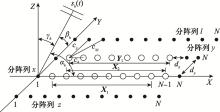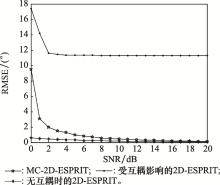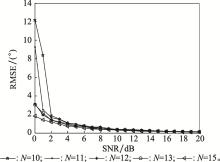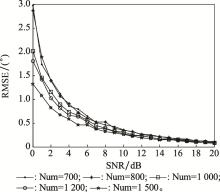| 1 |
LIN Q Q , JING M , SHUAI P , et al. 2D-DOA estimator for coherently distributed sources using one snapshot[J]. The Journal of Engineering, 2019, 19, 5775- 5779.
|
| 2 |
TIAN Q , QIU T S , LI J C , et al. Robust adaptive DOA estimation method in an impulsive noise environment considering coherently distributed sources[J]. Signal Processing, 2019, 7, 343- 356.
|
| 3 |
DAI Z , SHAN Y , LIU Y . Central direction-of-arrival estimation of coherently distributed sources based on rank-reduction theory[J]. Procedia Computer Science, 2018, 4, 918- 924.
|
| 4 |
ZHANG H W , XIE J W , SHI J P , et al. Antenna selection in MIMO radar with collocated antennas[J]. Journal of Systems Engineering and Electronics, 2019, 30 (6): 1119- 1131.
doi: 10.21629/JSEE.2019.06.08
|
| 5 |
HUANG Q H , FENG J J , FANG Y . Two-dimensional DOA estimation using one-dimensional search for spherical arrays[J]. Chinese Journal of Electronics, 2019, (6): 1259- 1264.
|
| 6 |
XIONG K L , LIU Z M , WANG P . SAGE-based algorithm for DOA estimation and array calibration in the presence of sensor location errors[J]. Journal of Systems Engineering and Electronics, 2019, 30 (6): 1074- 1080.
doi: 10.21629/JSEE.2019.06.03
|
| 7 |
LIU S , ZHAO J . 2D-DOA estimation algorithm with increased degrees of freedom for two parallel linear arrays[J]. China Communications, 2020, (6): 101- 108.
|
| 8 |
LIN X P , ZHANG X F , HE L , et al. Multiple emitters localization by UAV with nested linear array: system scheme and 2D-DOA estimation algorithm[J]. China Communications, 2020, (3): 117- 130.
|
| 9 |
WANG S X , ZHAO Y . Joint 2D-DOA and Doppler frequency estimation for L-shaped array using compressive sensing[J]. Journal of Systems Engineering and Electronics, 2020, 31 (1): 28- 36.
|
| 10 |
CHEN X Q , WANG C H , ZHANG X F . A real-valued 2D-DOA estimation algorithm of noncircular signal via euler transformation and rotational invariance property[J]. Transactions of Nanjing University of Aeronautics and Astronautics, 2018, 35 (3): 437- 448.
|
| 11 |
FENG M Y , HEM H , HAN J . 2D-DOA estimation using off-gridsparse learning via iterative minimization with L-parallel coprimearray[J]. Chinese Journal of Electronics, 2018, 27 (6): 1322- 1328.
doi: 10.1049/cje.2017.11.002
|
| 12 |
FAYAD Y , WANG C Y , CAO Q S . Temporal-spatial subspaces modern combination method for 2D-DOA estimation in MIMO radar[J]. Journal of Systems Engineering and Electro nics, 2017, 27 (4): 697- 702.
|
| 13 |
KUANG J M , ZHOU Y , FEI Z S . Joint DOA and channel estimation with data detection based on 2D unitary ESPRIT in massive MIMO systems[J]. Frontiers of Information Techno-logy & Electronic Engineering, 2017, 18 (6): 841- 849.
|
| 14 |
YEH C C , LEOU M L , UCCI D R . Bearing estimations with mutual coupling present[J]. IEEE Trans.on Antennas and Propagation, 1989, 37, 1332- 1335.
doi: 10.1109/8.43546
|
| 15 |
NG B C , SEE C M S . Sensor array calibration using maximum-likelihood approach[J]. IEEE Trans.on Antennas and Propagation, 1996, 42, 827- 835.
|
| 16 |
SEE C M S , POTH B K . Parametric sensor array calibration using measured steering vectors of uncertain locations[J]. IEEE Trans.on Signal Processing, 1999, 47, 1133- 1137.
doi: 10.1109/78.752611
|
| 17 |
YE Z , LIU C . On the resiliency of MUSIC direction finding against antenna sensor coupling[J]. IEEE Trans.on Antennas and Propagation, 2008, 56 (2): 371- 380.
doi: 10.1109/TAP.2007.915461
|
| 18 |
YE Z , LIU C . 2D-DOA estimation in the presence of mutual coupling[J]. IEEE Trans.on Antennas and Propagation, 2008, 56 (10): 3150- 3158.
doi: 10.1109/TAP.2008.929446
|
| 19 |
司伟建, 初萍, 孙圣和. 通道幅相不一致的实时校正方法[J]. 系统工程与电子技术, 2011, 33 (10): 2179- 2183.
doi: 10.3969/j.issn.1001-506X.2011.10.07
|
|
SI W J , CHU P , SUN S H . Real-time calibration method for channel amplitude-phase mis-match[J]. Systems Engineering and Electronics, 2011, 33 (10): 2179- 2183.
doi: 10.3969/j.issn.1001-506X.2011.10.07
|
| 20 |
JAFFER A G. Constrained mutual coupling estimation for array calibration[C]//Proc. of the 35th Asilomar Conference on Signal, Systems and Computers, 2001.
|
| 21 |
SELLONE F , SERRA A . A novel mutual coupling compensation algorithm for uniform and linear arrays[J]. IEEE Trans.on Sig nal Processing, 2007, 55 (2): 560- 573.
doi: 10.1109/TSP.2006.885732
|







